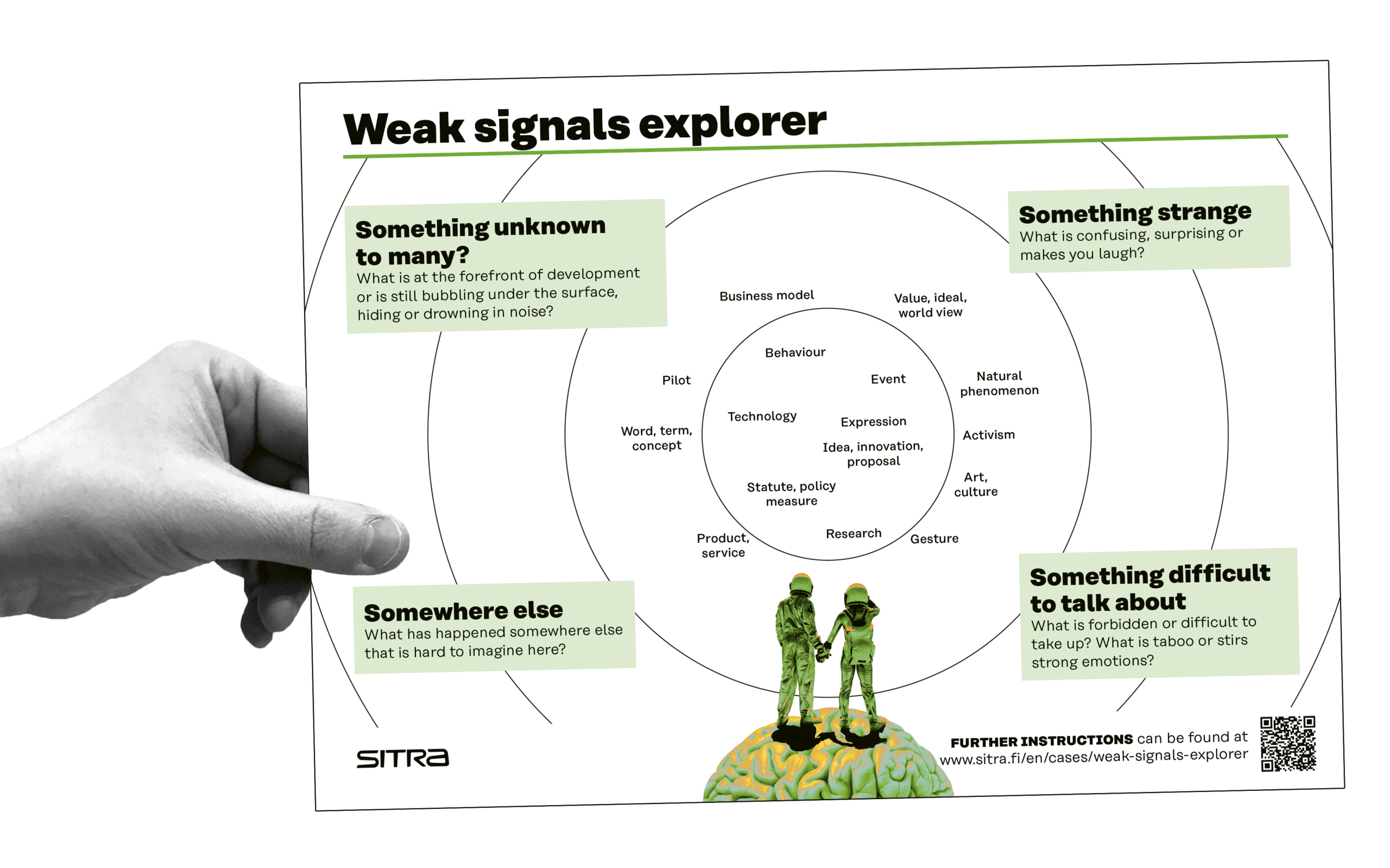Foresight is the study and investigation of alternative futures. Weak signals provide one way to do this. A weak signal is the first symptom of a change or a sign of an emerging thing that may be significant in the future (Hiltunen 2010). It is something that has actually already happened, but that seems strange, surprising, ridiculous or outrageous and can be interpreted as a sign of a bigger and potential change. The signal can be a new service, opinion, gesture, business model or statute, for example.
Weak signals explorer for observing weak signals consists of four questions that figuratively direct thinking to new orbits, further away from the areas of our everyday observation. The idea behind the questions is to guide us to look for topics and areas that we may not necessarily contemplate on daily and thus identify weak signals. The Explorer directs you to look further, beneath the surface, into oddities and taboos.
The Explorer can be used to support one’s own observation, but also in workshop work. However, it is good to remember that sometimes the observation of signals takes time and may not succeed right way as a task assigned in the workshop but may require some warm-up.
More instructions and tips on using the tool can be found in the Weak signals guide.
Preparation
Decide on the theme or topic whose related weak signals you wish to observe. It is worth choosing a fairly broad definition, such as the future of health care.
Agree on the period of time during which you will carry out the observation. A period of two weeks or a month, for example, can be a good way to start.
Select a place where you will collect signals. As a documentation platform, you should choose an app familiar to the participants, which everyone can also easily access on mobile devices. This way, signals can be documented as soon as they are spotted, regardless of place. Padlet, Pinterest, or Teams can be suitable solutions. Also agree on a consistent documentation policy. Often it is enough to write down the title, a brief description and source of the signal, e.g. a link to news or even a reference to a conversation with a neighbour
Working
1. Probe the world through the following questions for the agreed period of time (or a period agreed in the workshop):
- Somewhere else: What has happened somewhere else that is hard to imagine here
- Something that a lot of people do not know yet: What is at the forefront of development or is still bubbling under the surface?
- Something strange: What is confusing, surprising or makes you laugh?
- Something that is difficult to talk about: What is forbidden or difficult to take up? What is taboo or stirs strong emotions?
To be able to look further, beneath the surface, into the oddities and taboos, for example, follow media that you normally would not, talk to people outside your own environment, explore fields and themes in science, business, art and culture that you are not familiar with, and make every an effort to expose yourself to the new and strange. Weak signals can take many forms, from news headlines to human gestures and everything in between. Examples can be found in the Probe.
2. Document the signals you have detected in a place you have agreed.
3. Get together to discuss the signals. Categorise them and discuss which of the things, you have observed, you consider to be weak signals.
4. Interpret your observations: what kinds of first symptoms of change do the signals tell about in your opinion? What if the signals became mainstream? In the interpretation, you can also use Sitra’s tools First symptoms of change and Speculate on futures.
Tips
- Further instructions and tips on using the Explorer can be found in the Weak signals guide.
Materials
- Weak signals exlorer (PDF)
Additional reading
- Elina Hiltunen’s doctoral dissertation on weak signals



Recommended
Have some more.
Weak signals from the future
Speculate on futures
First symptoms of change